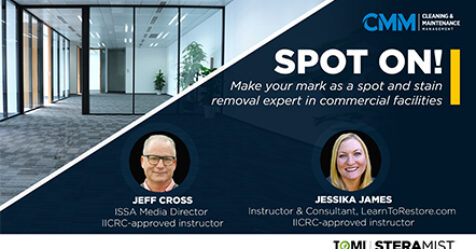All wet cleaning involves chemistry, even if that chemistry simply involves water or steam.
Therefore, we will not here rail against the use of chemicals in cleaning, because, yes, there is a time and a place for well-targeted or “surgical” chemistry — i.e., use of petrochemicals — as a necessary evil when dealing with mineral deposits, or in the case of a MRSA outbreak in your school, or in certain healthcare applications, for example.
At the risk of stating the obvious, the right way to use potent chemical cleaners and disinfectants is to follow manufacturer’s directions.
Those guidelines are revealing as they often require products be applied in the right strength or Dilution, be allowed to Dwell or soak, followed by Thorough Rinsing.
Remember the acronym, DDT:
- Dilute
- Dwell
- Thoroughly Rinse.
The reason for Dilution of many EPA-registered disinfectants, beyond enabling use-economy when using concentrates, is to ensure these pesticides are used in
The registered-chemical solution then must Dwell on the surface, staying wet for perhaps five to 10 minutes to achieve label kill claims.
(Possibly the reason that cleaning for appearance is so prevalent is due to the fact, that, in most cases, a five to 10 minute Dwell time is not practical, nor is the rinsing of the surfaces.)
Lastly, toxic or semi-poisonous residues often should be Thoroughly Rinsed from surfaces to reduce the risk of skin irritation, and ingestion of residual toxics by workers, children or other sensitive populations.
Rinsing with fresh water also helps eliminate the buildup of residue that, ironically, re-attracts soils to surfaces, produces rapid re-dirtying of those surfaces and provides harborage for microbes or biofilm growth.
Using “cleaning” chemicals without carefully following directions — by improper dilution, wrong dwell times and poor or nonexistent rinsing — is putting the cart before the horse, because chemicals used improperly
Professionals following a Health Intentional Cleaning protocol avoid this scenario by carefully following directions on registered-chemical-solution labels and using non-petrochemical interventions whenever possible, thus avoiding the DDT-error trap.
For more information on Health Intentional Cleaning methods, visit www.HealthIntentionalCleaning.org.
This special online series and its articles are sponsored by Advanced Vapor Technologies, LLC.
Health Intentional Cleaning®, Cleaning for Health®, and Renewable Cleaning®



